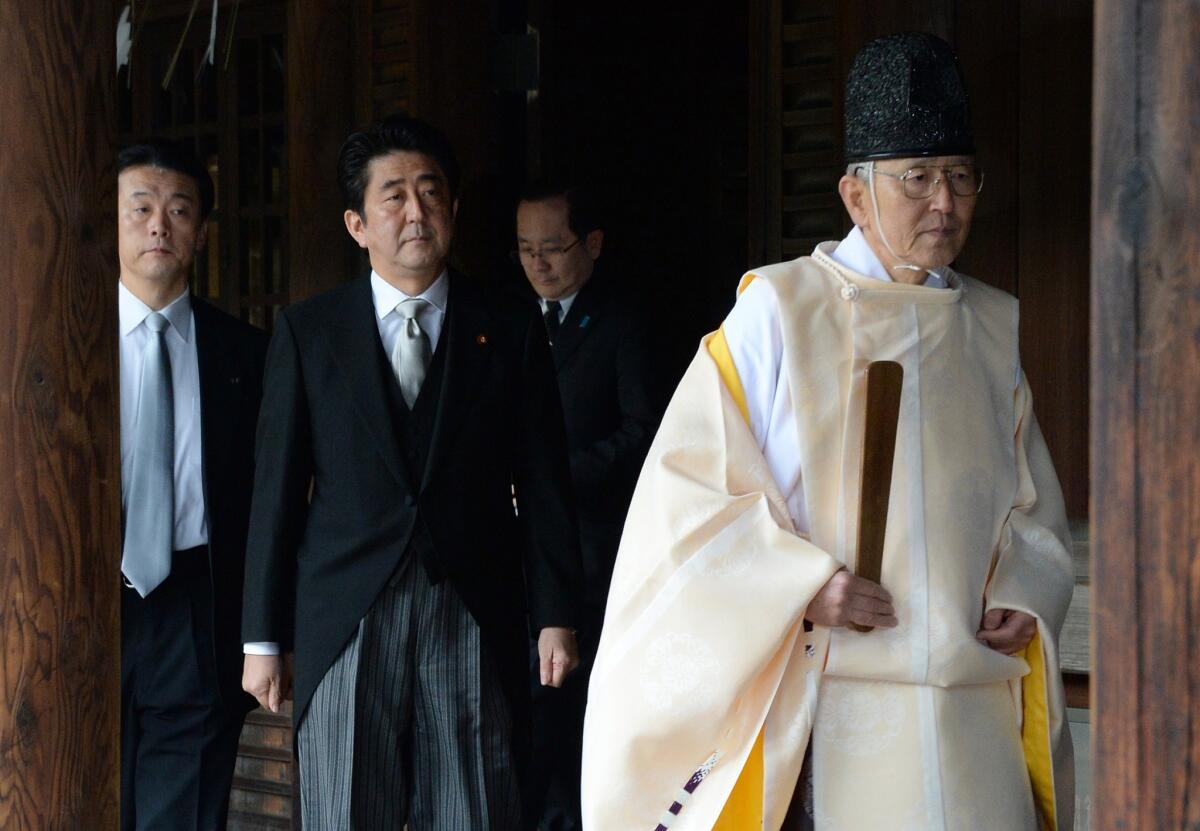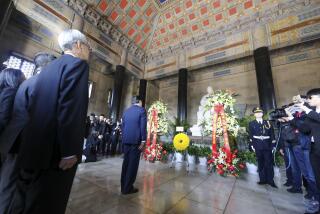Abe visits shrine to Japanese war dead, angering neighbors, U.S.

Japanese Prime Minister Shinzo Abe visited a controversial shrine to World War II dead, including 14 convicted war criminals, ignoring U.S. advice against gestures bound to strain already tense relations with neighbors China and South Korea.
Abe told Japanese news media the visit was intended “to report the progress of the first year of my administration and convey my resolve to build an era in which the people will never again suffer the ravages of war.”
But the visit drew immediate rebuke from Beijing and Seoul, where officials fear Japan’s nationalist leader is steering his country back to the militarism of the war years and those preceding it.
China’s Foreign Ministry summoned the Japanese ambassador in Beijing to formally protest Abe’s visit to the Yasukuni shrine in Tokyo, the first by a sitting prime minister since 2006.
The visit “has created major new political obstacles for already strained Sino-Japanese relations, and China won’t ever tolerate it,” Foreign Minister Wang Yi said in a statement. He warned that if Japan continues its provocative course of action, “China will surely keep it company to the end.”
Abe’s visit and the first anniversary of his second term as prime minister also coincided with events in China commemorating the 120th birthday of late leader Mao Tse-tung.
Relations between the two Asian economic giants have been increasingly tense since Japan’s purchase last year of uninhabited islands in the East China Sea that Tokyo claims as the Senkakus and Beijing as the Diaoyus. China last month retaliated by pronouncing an air defense identification zone over the disputed islands and demanding that any aircraft overflying the region inform Beijing authorities of their flight plans. Both Japan and China have scrambled warplanes to demonstrate control of the air and maritime spaces, provoking fear of an accident or escalation.
The new Chinese air exclusion zone also overlaps air space claimed by South Korea, which has its own dispute with Japan over islands in the strategic and mineral-rich East Asian maritime corridor.
South Korean Culture Minister Yoo Jin Ryong deplored Abe’s visit to the shrine, which he said “glorifies Japan’s history of militaristic aggression and colonial rule.”
During a visit to Japan in October, U.S. Secretary of State John F. Kerry and Defense Secretary Chuck Hagel advised Abe to avoid ratcheting up regional tension by visiting the Yasukuni shrine, the Japan Times said in its article on Thursday’s visit. The shrine honors 2.5 million war dead, including wartime Prime Minister Hideki Tojo and 13 others convicted of Class-A war crimes.
“The United States is disappointed that Japan’s leadership has taken an action that will exacerbate tensions with Japan’s neighbors,” the U.S. Embassy in Tokyo said in a statement that first described Japan as “a valued ally and friend.”
“The United States hopes that both Japan and its neighbors will find constructive ways to deal with sensitive issues from the past, to improve their relations, and to promote cooperation in advancing our shared goals of regional peace and stability,” the statement said.
In an extensive discussion of his visit published by the Yomiuri Shimbun newspaper, Abe attributed the criticism of neighbors and allies to “misunderstanding that a visit to Yasukuni Shrine is an act of worshiping war criminals.”
“I came today to express my determination and pledge to build an era in which people will not suffer from the horrors of war,” Abe said. “I haven’t the slightest intention of hurting the feelings of people in China and South Korea.”
Twitter: @cjwilliamslat
More to Read
Sign up for Essential California
The most important California stories and recommendations in your inbox every morning.
You may occasionally receive promotional content from the Los Angeles Times.











